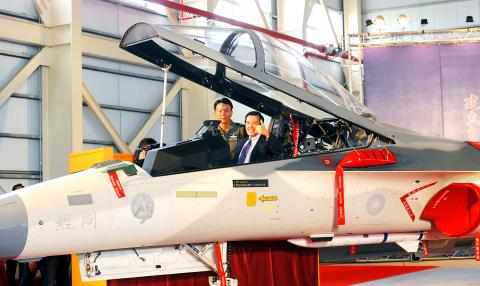With efforts to acquire F-16C/D aircraft from the US in limbo, the air force was yesterday given a shot in the arm when it received the first six of a planned 71 upgraded multi-role Indigenous Defence Fighters (IDF).
The F-CK-1A/B MLU (“mid-life upgrade”) was unveiled during a handover ceremony at the Aerospace Industrial Development Corp (AIDC, 漢翔航空) plant in Shalu (沙鹿), Greater Taichung, attended by top brass and scores of politicians, including President Ma Ying-jeou (馬英九), Deputy Minister of National Defense Chao Shih-chang (趙世璋) and Taichung Mayor Jason Hu (胡志強).
Years in the making, the upgrade involves a revamping of the aircraft’s avionics and flight control systems, a triple-color heads-up display and anti-electronic jamming functions, as well as the full integration of air-to-ground and air-to-air missiles developed by the Chungshan Institute of Science and Technology (中山科學研究院), such as the Tien Chien II “Sky Sword.”

Photo: Sam Yeh, AFP
It is reported that the aircraft will also be fit to carry the Tien Chien IIA anti-radiation missile, which remains under development. The aircraft can now carry four air-to-air missiles, from two on the original model.
Although it had been previously reported that the upgraded aircraft would have a greater operational range, the range is unchanged, and the twin Honeywell F125-70 afterburning turbofan engines are the same as on the original model.
The first six revamped aircraft, which are part of a US$588 million first phase of upgrades, are to join the 443 Tactical Fighter Wing in Greater Tainan.
Shiah Kang (夏康), senior vice president at state-owned AIDC, told the Taipei Times that between 28 and 30 F-CK-1A/B MLUs were scheduled for delivery this year, with the remainder due by the end of next year.
Shiah said that depending on the budget, the remainder of the IDFs in the air force, or 56 aircraft, could be upgraded as part of an MLU-2 program.
Under phase two of the project, AIDC would provide the air force with a range of options to meet a variety of tactical requirements, he said.
Addressing the ceremony, Ma said that when the IDF, a domestic program, was being developed in the 1980s after the US refused to sell Taiwan F-20s and F-16s, skeptics would jest that IDF stood for “I don’t fly.”
Over the years, the meaning of the acronym has changed and I hope it can now stand for “I do fight” and “I don’t fail,” Ma said.
The initial IDFs were introduced to the air force in 1994, with the first revamping program launched in 2000.
While the upgrade points to advances in Taiwanese avionics and capabilities, defense experts and Lockheed, maker of the F-16, say the new IDF is insufficient to ensure parity with an increasingly modern People’s Liberation Army Air Force.
In addition to the IDF program, a US$4.5 billion plan to upgrade Taiwan’s fleet of 144 F-16A/Bs is expected to commence later this year or next year.

Auckland rang in 2026 with a downtown fireworks display launched from New Zealand’s tallest structure, Sky Tower, making it the first major city to greet the new year at a celebration dampened by rain, while crowds in Taipei braved the elements to watch Taipei 101’s display. South Pacific countries are the first to bid farewell to 2025. Clocks struck midnight in Auckland, with a population of 1.7 million, 18 hours before the famous ball was to drop in New York’s Times Square. The five-minute display involved 3,500 fireworks launched from the 240m Sky Tower. Smaller community events were canceled across New Zealand’s

The Ministry of Foreign Affairs (MOFA) yesterday said it is closely monitoring developments in Venezuela, and would continue to cooperate with democratic allies and work together for regional and global security, stability, and prosperity. The remarks came after the US on Saturday launched a series of airstrikes in Venezuela and kidnapped Venezuelan President Nicolas Maduro, who was later flown to New York along with his wife. The pair face US charges related to drug trafficking and alleged cooperation with gangs designated as terrorist organizations. Maduro has denied the allegations. The ministry said that it is closely monitoring the political and economic situation

UNRELENTING: China attempted cyberattacks on Taiwan’s critical infrastructure 2.63 million times per day last year, up from 1.23 million in 2023, the NSB said China’s cyberarmy has long engaged in cyberattacks against Taiwan’s critical infrastructure, employing diverse and evolving tactics, the National Security Bureau (NSB) said yesterday, adding that cyberattacks on critical energy infrastructure last year increased 10-fold compared with the previous year. The NSB yesterday released a report titled Analysis on China’s Cyber Threats to Taiwan’s Critical Infrastructure in 2025, outlining the number of cyberattacks, major tactics and hacker groups. Taiwan’s national intelligence community identified a large number of cybersecurity incidents last year, the bureau said in a statement. China’s cyberarmy last year launched an average of 2.63 million intrusion attempts per day targeting Taiwan’s critical

‘SLICING METHOD’: In the event of a blockade, the China Coast Guard would intercept Taiwanese ships while its navy would seek to deter foreign intervention China’s military drills around Taiwan this week signaled potential strategies to cut the nation off from energy supplies and foreign military assistance, a US think tank report said. The Chinese People’s Liberation Army (PLA) conducted what it called “Justice Mission 2025” exercises from Monday to Tuesday in five maritime zones and airspace around Taiwan, calling them a warning to “Taiwanese independence” forces. In a report released on Wednesday, the Institute for the Study of War said the exercises effectively simulated blocking shipping routes to major port cities, including Kaohsiung, Keelung and Hualien. Taiwan would be highly vulnerable under such a blockade, because it